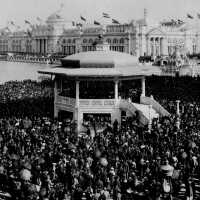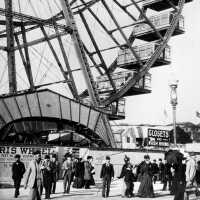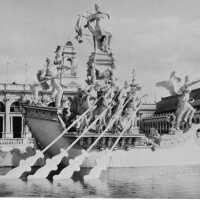Chicago World's Columbian Exposition, part 2

2021.87.67
FOR CHICAGO IT WAS DO OR DIE—The pressure of hosting the 1893 Exposition was enormous. There was so much at stake—was Chicago more than a giant stockyard, was culture alive west of New York, and could Chicago compete with previous World Fair hosts: Vienna, London, and Paris? The Paris Exposition of 1889, four years earlier, was a tough act to follow. The outstanding attraction of the Paris Expo was the design and erection of the Eiffel Tower—an instant worldwide attraction. The engineer/designer, Gustave Eiffel, even offered his design services to the Chicago group. But Fair Designer Daniel Burnham knew this had to be an American show, and we would live or die on the abilities of American artists and designers. But the fair did need something special that would bring out the “Holy Cow!” in visitors. The big idea was presented in the final year of construction, and Burnham wasn’t all that crazy about it. He grudgingly approved it but harbored a deep fear of “what if it doesn’t work?” Burnham had good reason to worry—the idea was gargantuan and equally preposterous. The designer, George W. Ferris, proposed a giant wheel, 264 feet high, with 36 suspended cars that would each carry 60 passengers. The man was either truly mad or an engineering genius. Ferris didn’t get the go-ahead until Nov. 1892—leaving him an impossible deadline to meet the May opening date. Somehow, someway, Ferris got the job done, and in June a band conductor blew his whistle; and the Iowa State Marching Band—40 strong—began playing and marched into one of the waiting cars. And the band kept on playing as they went up in the air in the world’s first and biggest ever Ferris wheel. The Chicago World’s Fair of 1893 boasts an impressive resume: It was the largest and most impressive exposition ever staged. Over 27 million attendees—almost half of America’s population—came to Chicago to see the latest wonders of the world. And travel in the 1890’s wasn’t a snap. Your choices were horse & buggy, passenger trains, or steamships from Michigan or Europe. It cost 50 cents to get in the fair, but there was so much to see a visitor would need three weeks and have to walk over 150 miles to see everything! Chicago set the bar so high that no other world’s fair or exposition ever came close. Chicago’s city motto is “I WILL.” And they did. by Rob Carey FAIR FACTS & FIGURES: Opening: May 1, 1893 Closing: Oct. 31, 1893 Total Attendance: 27 million Chicago Day Attendance: 770,000 Fair size: 633 acres Cost of Fair: $30.5 million Gross Receipts: $33 million Buildings: 200 Exhibitors: 79 Foreign 38 U.S. States CAPT. FREDERICK PABST won the Blue Ribbon as the best beer at the World’s Fair. Capt. Pabst was a former master on Lake Michigan steamers carrying passengers to & from Chicago. SAUGATUCK Oct 6, 1893—Chief Simon Pokagon of the Potawotomies, addressed the Indian committee of the World’s Fair congress the other day and told them that just 60 years ago his father sold for his tribe one million acres of ground including the site of the Columbian exposition to the United States for three cents an acre. He has been to Washington and says his people will get their money this fall. Chief Pokagon lived in Berrien county with the remnant of the tribe made immortal by J. Fennimore Cooper in “Oak Openings,” the principal scenes of which are located along the Kalamazoo river.
Remembering When
Winthers, Sally
Digital data in CatalogIt
Carey, Rob 1928-2019Sheridan, John "Jack" O. 1938-Schmiechen, James A.Pokagon, Chief Simon
Chicago, Illinois
Local Observer
12/31/2021
11/18/2023





